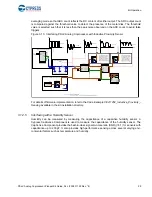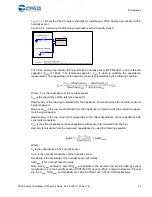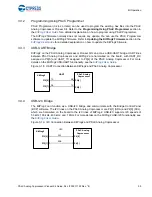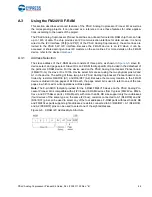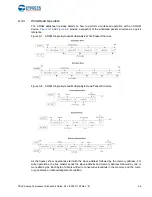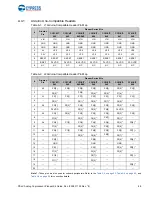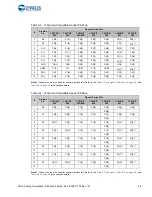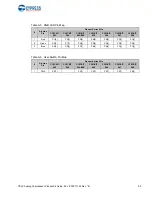
PSoC Analog Coprocessor Pioneer Kit Guide, Doc. # 002-11190 Rev. *B
43
LED states. An amber LED indicates the status of power supplied to the kit. The kit also has a gen-
eral-purpose RGB LED for user applications.
A.2.9
Push Buttons
The board contains a reset button (SW1) and two user buttons. The reset button is connected to the
RESET pin of the PSoC Analog Coprocessor and is used to reset the device. One user button
(SW2) is connected to P0[3] of the PSoC Analog Coprocessor. The other user button (SW3) is con-
nected to P1[2] of the PSoC 5LP device. All the push buttons connect to ground on activation (active
LOW).
A.2.10
Cypress Ferroelectric RAM (F-RAM)
The PSoC Analog Coprocessor Pioneer Kit contains an F-RAM device (
) that can be
accessed through I2C lines P4 [0] and P4 [1] of the PSoC Analog Coprocessor. The F-RAM has a
capacity of 1-Mbit (128 KB) with an I2C speed up to 3.4 MHz. The I2C slave address of the F-RAM
device is 7 bits wide, and the two least significant bits are configurable through physical pins. These
pins are hard-wired to 00 on the board. By default, the address of the F-RAM device used on the kit
is 0x50. This address can be modified by changing the R44/R39 and R36/R37 resistor pairs. The
operating voltage range of the F-RAM is between 2 V and 3.6 V. To prevent the F-RAM from operat-
ing at voltages greater than 3.6 V, the power supply to the F-RAM is derived from the output of the
3.3-V regulator. The I2C lines are connected to the 3.3-V side of the onboard level translator to allow
the F-RAM device to communicate with the PSoC Analog Coprocessor operating at 5 V. For more
information on using the F-RAM, see
Using the FM24V10 F-RAM chapter on page 44
A.2.11
External Crystals
The PSoC Analog Coprocessor Pioneer board has a provision to use a 32.768-kHz (Y1) external
crystal for the WCO input. The WCO is used to provide an accurate low-frequency clock to PSoC
Analog Coprocessor for Deep Sleep wake up intervals, and WDT reset intervals.

